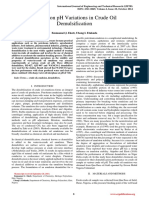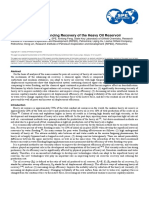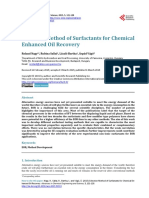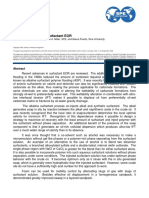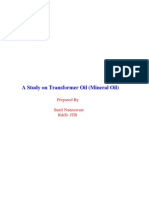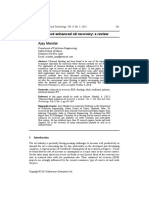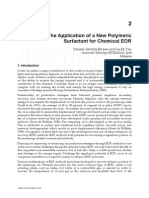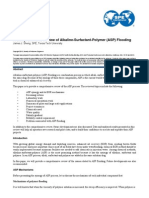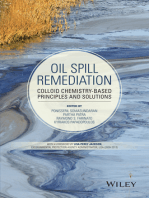Journal of Petroleum Science and Engineering: Jinmei Bai, Tongyao Zhang, Weiyu Fan
Journal of Petroleum Science and Engineering: Jinmei Bai, Tongyao Zhang, Weiyu Fan
Uploaded by
Mikael SalamancaCopyright:
Available Formats
Journal of Petroleum Science and Engineering: Jinmei Bai, Tongyao Zhang, Weiyu Fan
Journal of Petroleum Science and Engineering: Jinmei Bai, Tongyao Zhang, Weiyu Fan
Uploaded by
Mikael SalamancaOriginal Description:
Original Title
Copyright
Available Formats
Share this document
Did you find this document useful?
Is this content inappropriate?
Copyright:
Available Formats
Journal of Petroleum Science and Engineering: Jinmei Bai, Tongyao Zhang, Weiyu Fan
Journal of Petroleum Science and Engineering: Jinmei Bai, Tongyao Zhang, Weiyu Fan
Uploaded by
Mikael SalamancaCopyright:
Available Formats
Journal of Petroleum Science and Engineering 69 (2009) 189192
Contents lists available at ScienceDirect
Journal of Petroleum Science and Engineering
j o u r n a l h o m e p a g e : w w w. e l s ev i e r. c o m / l o c a t e / p e t r o l
Research paper
The synergetic effect between heavy oil components and emulsier in heavy oil-in-water emulsion
Jinmei Bai a,, Tongyao Zhang b, Weiyu Fan c
a b c
E-tech Oileld Technology Development Co., Ltd. Tianjin, 300384, China Institute of Oil Recovery Engineering CNOOC, Tanggu, Tianjin, 300452, China State Key Laboratory of Heavy Oil Processing in China University of Petroleum, Shandong, 257061, China
a r t i c l e
i n f o
a b s t r a c t
Resin and asphaltene were extracted from Gudao and Liaohe heavy oil by using the adsorption chromatography. Toluene and n-dodecane were selected as model oil, sodium dodecylbenzene sulfonate was selected as emulsier. The interfacial tension (IFT) was investigated without emulsier and adding emulsier, the effect of pH value on the interfacial tension was also investigated. The results show that the interaction between component and emulsier lies on the interfacial activity of components, and the higher interfacial activity is, the stronger interaction is. And the inuence of pH on IFT is great at acid and base conditions, but little at neutral condition. The synergetic effect between polar component and emulsier is stronger in the neutral condition and weak acid and base conditions. Crown Copyright 2009 Published by Elsevier B.V. All rights reserved.
Article history: Received 24 December 2007 Accepted 10 August 2009 Keywords: heavy oil components emulsiers interaction pH value interfacial tension
1. Introduction Emulsicationviscosityreduction is an important area of exploitation, pipeline transportation and processing of heavy oil. Researchers have studied the preparation and application of heavy oil-in-water emulsion (Zaki, 1997; Ahmed and Amal, 1999), but they did little research about the mechanism of emulsication and stabilization of heavy oil-in-water emulsion (Fan et al., 2001). They were only interested in the stability of heavy oil emulsion (McLean and Kilpatrick, 1997; Yang and Lu, 1998; Li, 1998). In order to widely apply emulsicationviscosityreduction technology, research about the mechanism of emulsication and stabilization of heavy oil-inwater emulsion should be studied in-depth. The bad adaptability of emulsiers and the unmanageable stabilization were caused by the differences of heavy oil components. The interaction between heavy oil components and emulsiers is the core of heavy oil-in-water emulsion's formation and stabilization. In this paper, resin and asphaltene was extracted from Gudao and Liaohe heavy oil with the method of adsorption chromatography. Toluene and n-dodecane were selected as model oil, sodium dodecylbenzene sulfonate(LAS) was selected as emulsier. The interfacial tension was investigated. When emulsier was added and before it was added, the effect of pH value on the interfacial tension was investigated separately.
2. Experimental Table 1 gives basic properties of Liaohe Du-84 heavy oil and Shengli Gudao heavy oil. Isolate heavy oil to polar components: the method to obtain polar components (saturate, aromatic, resin and asphaltene) is based on the Chinese petroleum industry standard method (SH/T 0509-92).The main conditions are as follows: Isolation of asphaltene: heavy oil:n-heptane = 1 g:50 mL; isolation of soluble fractions: 75150 m neutral Al2O3 columns. Acid number: using 0.1 M KOH/ethanol as titrant, V(toluene):V (hexamethylene):V(anhydrous ethanol):V(water) = 100:50:49:1 as titration solvent, pHS-3C pH value meter. Base nitrogen number: using perchloric acid/caproic acid as titrant, V(toluene):V(caproic acid) = 10:20 as titration solvent, then determining variation of electric potential (mV) with the volume of titrant (V), the point whose derivatives are the largest on the graph of mV versus V is the terminal point of titration. Ultimate analysis: Elementar Analy Sensysteme GmbH Vario Elc III ultimate analysis instrument (German). Determination of interfacial tension: interfacial tension of oil water is measured by spinning drop method at 50 C, using XZD-3 interfacial tension apparatus. Preparation of oil/water system: heavy oil, resin and asphaltene were regarded as solute; toluene and n-dodecane (W(toluene):W (n-dodecane) = 1:1) were selected as mix solvent, a series of model
Corresponding author. E-mail address: baijinmei_1982@hotmail.com (J. Bai).
0920-4105/$ see front matter. Crown Copyright 2009 Published by Elsevier B.V. All rights reserved. doi:10.1016/j.petrol.2009.08.008
190 Table 1 Basic properties of Liaohe and Gudao heavy oil. Heavy oil Gudao LiaoheDu-84 Density (20 C)/ (g cm 3) 0.9934 1.0001
J. Bai et al. / Journal of Petroleum Science and Engineering 69 (2009) 189192
Viscosity (80 C) /(mm2 s 1) 810.38 4898.92
Solidication point/ C 8.5 42
Acid number/ mg KOH g 1 3.25 9.05
Gudao is a production base of heavy oil in Shengli Oil eld which is the second oil eld of China. Liaohe Oil eld is the third oil eld of China, most of its reserve is heavy oil.
oil containing 0.55% (w/w) solute were prepared. Sodium dodecylbenzene sulfonate was selected as emulsier. According to the experimental demand, the variational aqueous phase was deionized water, de-ionized water in different pH value, or emulsier aqueous solution. 3. Results and discussion 3.1. Elemental properties of two kinds of heavy oil and their polar components The elemental properties of two kinds of heavy oil and their polar components as shown in Table 2 can reveal the following results: The sequence of fractions content is: resin > aromatic > saturate > asphaltene. Compared with Gudao heavy oil, there are more resins and less asphaltenes in Liaohe heavy oil. The acid number of two kinds of heavy oil and their fractions suggests that they are different in the distribution of acid number and the composition of acidic substance. The nitrogen number of two kinds of heavy oil and their fractions indicates that they are different in the composition of basic nitride. The results of ultimate analysis got the conclusion that: compared with Gudao heavy oil and its corresponding components, the Liaohe heavy oil and its polar components have higher degree of unsaturation, higher content of nitrogen and oxygen, and higher acid number. And most of nitrogen and oxygen atoms consist in resin and asphaltene. Basic properties showed that there are more differences between two kinds of heavy oil and their polar components, which make it easy to review the inuence of component difference on interfacial property in the study. 3.2. Comparison of interfacial activities of two kinds of heavy oil and their polar components Interfacial tension is the most important parameter of oilwater interfacial property. It affects the adsorption rata and adsorbed
Table 2 Elemental properties of two kinds of heavy oil and their polar components. Heavy oil fractions Distribution/% Acid number/mg KOH g 1 3.25 9.05 0.23 0.22 2.79 9.74 Nitrogen number/g g 1 13441 8106 13671 13149 13212 20830
amount of polar components in oil/water interface and also affects the interfacial structure. It is the appearance of interaction between polar components and emulsier. In order to compare two kinds of heavy oil and their polar components' interfacial activity, the inuence of dosage of heavy oil and its polar components in simulated oil on oilwater interfacial tension was studied. Table 3 shows the results. Blank interfacial tension is the oil/water interfacial tension of blank model oil and de-ionized water without components. The data of Table 3 show that the existence of heavy oil and polar components reduce the oil/water interfacial tension of model oil, and the tendency of oil/water interfacial tension reduces with the increasing of polar components' contents. Results indicate that the adsorbed amount of natural surfactant existing in crude oil increases with the increasing of polar components' contents, it goes into saturation under certain concentrations. Interfacial pressure is the variation of the oil/water interfacial tension with and without surfactant. = is the symbol for interfacial pressure, stands for the oil/water interfacial tension without surfactant, stands for the oil/water interfacial tension with surfactant. Interfacial pressure is the symbol of interfacial activity. Interfacial pressure increases with the adsorbate amount of surfactant in surface. The larger interfacial pressure in the same concentration, the stronger the ability of reducing interfacial tension will be. Table 4 gives the inuences of heavy oil and its components amount in model oil on oilwater interfacial pressure. The data of Table 4 show that the interfacial pressure of two kinds of heavy oil and their polar components are different in the same concentration, that is, their interfacial activities are different. The sequence of the interfacial activity (IFA) of Gudao heavy oil and its polar components is IFA (heavy oil) > IFA(resin) > IFA (asphaltene). The sequence of the IFA of Liaohe heavy oil and its polar components is IFA (asphaltene) > IFA(heavy oil) > IFA (resin). The interfacial activity of Liaohe heavy oil and its polar fractions is superior to that of Gudao. From elemental properties and the IR spectrum of asphaltene, we can know there are hydroxide radical, amidocyanogen, carbonyl group and carboxyl in asphaltene molecule, and Liaohe asphaltene has more than others, so there is more hydrogen bond in asphaltene which leads to stronger interfacial activity of asphaltene (Fig. 1). 3.3. Effects of the interaction of heavy oil components and emulsiers on interfacial tension In order to review the inuences of the interaction between components and emulsier on interfacial tension, the variation of interfacial tension with the concentration of fractions in the model oil with 1% emulsier was studied. Table 5 gives the results.
Element fractions/% C 84.01 86.50 86.73 87.07 84.25 87.87 82.97 85.53 80.62 81.92 H 10.92 10.91 13.12 12.87 10.70 10.57 9.85 9.93 8.72 8.65 N 0.57 0.81 0 0 0.24 0.34 1.39 1.74 1.21 1.71 O 0.64 1.33 0 0 0.19 0.19 1.40 1.57 1.96 3.13 S 3.31 0.42 0 0 4.16 4.16 3.99 0.55 6.37 0.51
n(H)/n(C)
Gudao heavy oil Liaohe heavy oil Gudao saturates Liaohe saturates Gudao aromatics Liaohe aromatics Gudao resins Liaohe resins Gudao asphaltenes Liaohe asphaltenes
25.08 26.07 31.39 28.49 34.88 41.65 6.65 3.38
1.56 1.51 1.82 1.77 1.52 1.44 1.42 1.39 1.30 1.26
The amount of resins is calculated according to difference; the amount of oxygen is the actual value examined.
J. Bai et al. / Journal of Petroleum Science and Engineering 69 (2009) 189192 Table 3 The inuences of heavy oil and its components amount in model oil on oilwater interfacial tension. Model oil /mNm 1 Blank Gudao heavy oil Gudao resins Gudao asphaltenes Liaohe heavy oil Liaohe resins Liaohe asphaltenes 41.45 41.45 41.45 41.45 41.45 41.45 0.5% 26.84 34.96 35.30 22.82 39.54 9.96 1.0% 25.44 34.58 34.91 21.74 32.22 8.15 2.0% 24.44 31. 90 32.85 17.84 31.91 8.13 3.0% 24.06 27.35 31.02 17.08 25.37 8.01 4.0% 23.63 26.89 29.55 16.17 23.79 7.94 5.0% 23.02 25.14 27.57 14.95 23.65 7.32 Gudao heavy oil Gudao resins Gudao asphaltenes Liaohe heavy oil Liaohe resins Liaohe asphaltenes
191
Table 5 The variation of interfacial tension with the concentration of fractions in the model oil (with 1% emulsier). Model oil /mNm 1 Blank 3.28 3.28 3.28 3.28 3.28 3.28 0.5% 2.85 3.33 3.41 2.79 3.08 1.30 1.0% 2.55 2.93 3.22 2.62 3.31 0.70 2.0% 2.34 2.74 3.34 1.95 3.16 0.25 3.0% 2.44 2.82 3.06 1.94 3.67 0.29 4.0% 2.43 2.95 3.16 1.93 3.26 0.35 5.0% 2.40 2.89 3.02 1.95 3.62 0.35
Table 4 The inuences of heavy oil and its components amount in model oil on oilwater interfacial pressure. Model oil /mNm 1 Blank Gudao heavy oil Gudao resins Gudao asphaltenes Liaohe heavy oil Liaohe resins Liaohe asphaltenes 0 0 0 0 0 0 0.5% 14.61 6.49 6.15 18.63 1.91 31.49 1.0% 16.01 6.87 6.54 19.71 9.23 33.30 2.0% 17.01 9.55 8.60 23.61 9.54 33.32 3.0% 17.39 14.10 10.43 24.37 16.08 33.44 4.0% 17.82 14.56 11.90 25.28 17.66 33.51 5.0% 18.43 16.31 13.88 26.50 17.80 34.13
Table 6 The variation of interfacial tension difference with the concentration of fractions in the model oil (with 1% LAS). Model oil /mNm 1 Blank Gudao heavy oil Gudao resin Gudao asphaltene Liaohe heavy oil Liaohe resin Liaohe asphaltene 0 0 0 0 0 0 0.5% 0.43 0.05 0.13 0.49 0.20 1.98 1.0% 0.73 0.35 0.06 0.66 0.04 2.58 2.0% 0.94 0.54 0.06 1.33 0.12 3.03 3.0% 0.84 0.46 0.22 1.34 0.40 2.99 4.0% 0.85 0.33 0.12 1.35 0.02 2.93 5.0% 0.88 0.39 0.26 1.33 0.34 2.93
Blank interfacial tension is the interfacial tension of blank model oil and 0.1% LAS water solution without components. In order to compare the effect of the interaction between fractions and emulsier on interfacial tension, the difference of after and before adding components in xed concentration of emulsier as a parameter was made which is similar to interfacial pressure, and marked as . Table 6 gives the variation of under different concentrations of fractions. The results of Table 5 as follows: after the addition of heavy oil and polar component, the interfacial tension is lower than the blank. The fact indicates the interaction between natural surfactants in heavy oil and emulsier reduces the interfacial tension. The data of Table 6 reveal that the interaction between different fractions and emulsier did different effects on interfacial tension. The large interfacial activity fraction Liaohe asphaltene shows stronger cooperation. But the Gudao asphaltene and Liaohe resin of weak interfacial activity did little on the interfacial tension, this fact indicates that there wasn't distinct co-operation between them and emulsier. All in all, the interaction between heavy oil component and emulsier depends on the interfacial activity of heavy oil and its
components, the more active of component, the higher interaction it is. 3.4. Effect of pH value on interfacial tension of simulated oil system Aqueous phase is one of the dominant factors of emulsion's interfacial property. The effects of pH value on interaction between fractions and emulsier have been studied. The data of Figs. 25 indicate the effects of pH value of aqueous on interfacial tension. We can obtain regularity from Figs. 2 and 3 that before being added emulsier, the IFT of the two kinds of heavy oil and its polar components simulated oil and de-ionized water vary as follows. When it is pH < 7, the interfacial tension increases with the increasing of pH value. When it is pH > 7, the interfacial tension begins to reduce; the interfacial tension at the basic condition is lower than that in the acidic condition. The results above show that the interfacial activity of heavy oil and its polar fraction is great at basic conditions. The interfacial tension of model oil system changed with pH value after being added 1% emulsier. The results are shown in Figs. 4 and 5. We can know from Figs. 3 and 4 that after being added 1% emulsier, the interfacial tension of the blank model oil is lower in the
Fig. 1. IR spectrum of Gudao and Liaohe asphaltene.
Fig. 2. The inuences of pH value on IFT of Gudao heavy oil and its polar components model oil/de-ionized water. (1) 5% Gudao asphaltenes model oil, (2) 5% Gudao heavy crude model oil and (3) 5% Gudao resins model oil.
192
J. Bai et al. / Journal of Petroleum Science and Engineering 69 (2009) 189192
Fig. 3. The inuences of pH value on interfacial tension of Liaohe heavy oil and its polar components model oil-de-ionized water. (1) 5% Liaohe resins model oil, (2) 5% Liaohe heavy crude model oil and (3) 5% Liaohe asphaltenes model oil.
Fig. 5. The inuences of pH value on interfacial tension of Liaohe heavy oil and its polar components model oil and 1% emulsier in water. (1) 5% Liaohe resins model oil, (2) blank model oil, (3) 5% Liaohe heavy crude model oil and (4) 5% Liaohe asphaltenes model oil.
strong acidic and strong basic conditions, and it is even lower in the strong acidic condition, but the adding of heavy oil and their polar components doesn't change their interfacial tension much. That is, there is no distinct interaction between emulsier and components in the strong acidic and basic conditions. In the neutral and weak acidic and basic conditions with a pH value from 4 to 10, the adding of heavy oil and its polar components lowers the interfacial tension obviously and shows distinct interaction. This fact indicates that the inuence of pH is great at neutral, weak acidic and basic conditions, but little at strong acidic and basic conditions. The interfacial activity of emulsier is stronger than that of heavy oil and its polar fractions, the strong acidic and basic conditions cover up components' interfacial activity, but the stronger Liaohe heavy oil and its asphaltene show interaction in some way. Comparatively, the emulsier's adsorptive capacity in interface reduces in the neutral and weak acidic and basic conditions, and the heavy oil and its polar components adsorb competitively in interface, co-operate with emulsier, and they reduce the interfacial tension together. This fact attests that there is large interaction between heavy oil and its polar fraction and emulsier in the neutral and weak acidic and basic condition.
degree of unsaturation, higher content of nitrogen and oxygen, higher acid number and relatively stronger interfacial activity. (2) Liaohe asphaltene, which has a stronger interfacial activity, can reduce the oilwater IFT, shows a stronger synergetic effect with emulsier; Gudao asphaltene and Liaohe resin, which have a weaker interfacial activity, do not show any clear synergetic effect with emulsier. The interaction between polar component of heavy oil and emulsier lies on the interfacial activity of polar component: the stronger interfacial activity of component, the stronger interaction it is. (3) In the strong acidic and basic conditions, there is no distinct synergetic effect between emulsier and components; In the neutral and weak acidic and basic conditions with a pH value from 4 to 10, the IFT reduces obviously with the adding of heavy oil and its polar components, and shows stronger synergetic effect. This fact approves that there is interaction between heavy oil and its polar components and emulsier. References
Ahmed, Nehal S., Amal, M.F., 1999. Formation of uid heavy oil-in-water emulsions for pipeline transportation. Fuel 78 (3), 593600. Fan, Wei-yu, Chen, Shu-kun, Yang, Meng-long, et al., 2001. Study on stability of heavy crude oil in water emulsion III oil/water surface tension for heavy crude components and water system. Acta Petrol. Sin. (Petrol. Process. Sect.) 17 (5), 16. Li, M.Y., 1998. Investigation of stability of water-in-crude oil emulsion VI properties of interfacial lm and stability of crude oil emulsion. Acta Petrol. Sin. (Petrol. Process. Sect.) 14 (3), 14. McLean, J.D., Kilpatrick, P.K., 1997. Effects of asphaltene solvency on stability of water in crude oil emulsions. J. Colloid Interface Sci. 189, 242253. Yang, Xiao-li, Lu, Wan-zhen, 1998. Advances in stabilization and destabilization of water in crude oil emulsion. Oileld Chem. 15 (1), 8796. Zaki, Nael N., 1997. Surfactant stabilized crude oil-in-water emulsion for pipeline transportation of viscous crude oil. Colloids Surf. 125 (1), 1925.
4. Conclusion (1) Compared with Gudao heavy oil and its corresponding components, the Liaohe heavy oil and its polar components have higher
Fig. 4. The inuences of pH value on IFT of Gudao heavy oil and its polar components model oil and 1% emulsier in water. (1) blank model oil, (2) 5% Gudao asphaltenes model oil, (3) 5% Gudao heavy model oil and (4)5% Gudao resins model oil.
You might also like
- Astm D792Document6 pagesAstm D792Aabraham Samraj Ponmani100% (1)
- Usp 771 - Ophthalmic Products-Quality TestsDocument7 pagesUsp 771 - Ophthalmic Products-Quality TestsAdrianaNo ratings yet
- Pevonia Portfolio 2021Document57 pagesPevonia Portfolio 2021Tracy HoangNo ratings yet
- Ice Cream 15 PDF FreeDocument12 pagesIce Cream 15 PDF FreeYuni TiwiNo ratings yet
- Beggs (SPE 5434) Estimating The Viscosity of Crude Oil SystemsDocument2 pagesBeggs (SPE 5434) Estimating The Viscosity of Crude Oil SystemsOnur Deniz Narin100% (1)
- Demulsif SaltDocument12 pagesDemulsif SaltLidiya KirilovaNo ratings yet
- Interacción Surfactante-Polímero Sobre Las Propiedades Interfaciales de Una SustanciaDocument9 pagesInteracción Surfactante-Polímero Sobre Las Propiedades Interfaciales de Una SustanciaJesus BcNo ratings yet
- Studies On PH Variations in Crude Oil Demulsification: Emmanuel J. Ekott, Ubong I. EtukudoDocument3 pagesStudies On PH Variations in Crude Oil Demulsification: Emmanuel J. Ekott, Ubong I. EtukudoerpublicationNo ratings yet
- Bonilla 2013Document10 pagesBonilla 2013MaringanNo ratings yet
- Effects of Surfactants and Alkalis On The Stability of Heavy-Oil-in-Water EmulsionsDocument10 pagesEffects of Surfactants and Alkalis On The Stability of Heavy-Oil-in-Water EmulsionsEliasNo ratings yet
- Polimeric LawDocument5 pagesPolimeric LawFranklin Ivan Archer MartinezNo ratings yet
- Selection Method of Surfactants For Chemical Enhanced Oil RecoveryDocument8 pagesSelection Method of Surfactants For Chemical Enhanced Oil RecoveryAdhita MeryantoNo ratings yet
- Identification of Phases of Various Oil, Surfactant/ Co-Surfactants and Water System by Ternary Phase DiagramDocument9 pagesIdentification of Phases of Various Oil, Surfactant/ Co-Surfactants and Water System by Ternary Phase DiagramBushra ShaukatNo ratings yet
- SPE 115386 Recent Advances in Surfactant EORDocument35 pagesSPE 115386 Recent Advances in Surfactant EORFachrul saktiNo ratings yet
- Accepted Manuscript: 10.1016/j.petlm.2015.07.003Document20 pagesAccepted Manuscript: 10.1016/j.petlm.2015.07.003Arii WAhyudiiNo ratings yet
- SPE-193449-MS Investigating The Potential Use of Waste Vegetable Oils To Produce Synthetic Base Fluids For Drilling Mud FormulationDocument12 pagesSPE-193449-MS Investigating The Potential Use of Waste Vegetable Oils To Produce Synthetic Base Fluids For Drilling Mud FormulationSARTHAK BAPATNo ratings yet
- Modification of The Stability of Oil-In-Water Nano-Emulsions by Polymers With Different StructuresDocument10 pagesModification of The Stability of Oil-In-Water Nano-Emulsions by Polymers With Different StructuresAnand aashishNo ratings yet
- Hong 2018Document25 pagesHong 2018Zakiyah Kamto IrfinNo ratings yet
- Effects of Interfacial Tension, Oil Layer Break Time, Emulsification and Wettability Alteration On Oil Recovery For Carbonate ReservoirsDocument12 pagesEffects of Interfacial Tension, Oil Layer Break Time, Emulsification and Wettability Alteration On Oil Recovery For Carbonate ReservoirsDavid LópezNo ratings yet
- Hsieh 1977Document12 pagesHsieh 1977Ruben Cruces LiraNo ratings yet
- Deepa Subramanian, Kathleen Wu, Abbas Firoozabadi: Highlights GraphicalDocument8 pagesDeepa Subramanian, Kathleen Wu, Abbas Firoozabadi: Highlights Graphicalmanuel Fernando roa aridlaNo ratings yet
- SPE-176465-MS Experimental Investigation of Crude Oil Emulsion Physicochemical Properties and Demulsifier Dosage PredictionDocument24 pagesSPE-176465-MS Experimental Investigation of Crude Oil Emulsion Physicochemical Properties and Demulsifier Dosage PredictionGabriel EduardoNo ratings yet
- Crude Oil/Brine Interfacial TensionsDocument12 pagesCrude Oil/Brine Interfacial TensionsRosa K Chang HNo ratings yet
- Spe 178305 MS PDFDocument15 pagesSpe 178305 MS PDFShadrach OgirikiNo ratings yet
- AICHE2004Document19 pagesAICHE2004Antonio GuarascioNo ratings yet
- 2862-Article Text-16501-1Document14 pages2862-Article Text-16501-1BUN SaretNo ratings yet
- Stability Behavior of Water-in-Diesel Fuel Emulsion: M. T. Ghannam and M. Y. E. SelimDocument16 pagesStability Behavior of Water-in-Diesel Fuel Emulsion: M. T. Ghannam and M. Y. E. Selimdipali2229No ratings yet
- Enhanced Oil Recovery Techniques: SyllabusDocument48 pagesEnhanced Oil Recovery Techniques: Syllabusavula43No ratings yet
- SPE 69420 Oil Mixture Viscosity Behavior: Use in Pipeline DesignDocument8 pagesSPE 69420 Oil Mixture Viscosity Behavior: Use in Pipeline DesignGee San TayNo ratings yet
- Aspects of Rheological BehaviorDocument4 pagesAspects of Rheological Behaviorstranger3333No ratings yet
- Demulsification of W/O Emulsion at Petroleum Field and Reservoir Conditions Using Some Demulsifiers Based On Polyethylene and Propylene OxidesDocument11 pagesDemulsification of W/O Emulsion at Petroleum Field and Reservoir Conditions Using Some Demulsifiers Based On Polyethylene and Propylene OxidesLluísNo ratings yet
- Transformer OilDocument103 pagesTransformer Oilparasathya100% (1)
- Comparation of Oxidation Stability in Natural Insulating OilsDocument3 pagesComparation of Oxidation Stability in Natural Insulating OilsRomán M Martín del C100% (1)
- Petroleum Society 2Document8 pagesPetroleum Society 2Joel OlanNo ratings yet
- Components of Paraffin-Base and Naphthenic-Base CRDocument16 pagesComponents of Paraffin-Base and Naphthenic-Base CRNorma Arisanti KinasihNo ratings yet
- Technical-Paper-16712 Revised PDFDocument13 pagesTechnical-Paper-16712 Revised PDFDharamraj Suresh KumarNo ratings yet
- Experimental Investigation of Stability of Water in Oil Emulsions at ReservoirDocument13 pagesExperimental Investigation of Stability of Water in Oil Emulsions at ReservoirNour SwamNo ratings yet
- Chemical Flood Enhanced Oil Recovery A RDocument24 pagesChemical Flood Enhanced Oil Recovery A RMarcellinus SatrioNo ratings yet
- Breaking Emulsion (PDF)Document7 pagesBreaking Emulsion (PDF)adamsamodraNo ratings yet
- A Study On Combination of Polymer and CO Flooding Using Magnetic Resonance ImagingDocument4 pagesA Study On Combination of Polymer and CO Flooding Using Magnetic Resonance ImagingArii WAhyudiiNo ratings yet
- Development of A Methodology For The Optimization of Dehydration of Extra-Heavy Oil EmulsionsDocument16 pagesDevelopment of A Methodology For The Optimization of Dehydration of Extra-Heavy Oil Emulsionsmurdanetap957No ratings yet
- Effects of An Oxygenated Additive On The Emulsification Characteristics of Two - and Three-Phase Diesel EmulsionsDocument9 pagesEffects of An Oxygenated Additive On The Emulsification Characteristics of Two - and Three-Phase Diesel EmulsionsAbdoel Wahied ArohmanNo ratings yet
- Intechopen 82278Document23 pagesIntechopen 82278Alex HariucNo ratings yet
- Polymer Surfactant Assisted EORDocument27 pagesPolymer Surfactant Assisted EORAnurag GuptaNo ratings yet
- SPE-182836-MS Simulation of Ionic Liquid Flooding For Chemical Enhance Oil Recovery Using CMG STARS SoftwareDocument14 pagesSPE-182836-MS Simulation of Ionic Liquid Flooding For Chemical Enhance Oil Recovery Using CMG STARS SoftwareVeronicaNo ratings yet
- A Study of Various Factors Determining The Stability of MoleculesDocument5 pagesA Study of Various Factors Determining The Stability of MoleculesCHOFOR VITALISNo ratings yet
- Stability of Vitamin A in Oil in Water in Oil TypeDocument7 pagesStability of Vitamin A in Oil in Water in Oil TypeMuhammad Akbar SusenoNo ratings yet
- Emulsification of Heavy Crude Oil in Water For Pipeline Transportation PDFDocument7 pagesEmulsification of Heavy Crude Oil in Water For Pipeline Transportation PDFJesus AlbertoNo ratings yet
- Composition Shift Due To The Different Solubility in The Lubricant Oil For Multicomponent MixturesDocument9 pagesComposition Shift Due To The Different Solubility in The Lubricant Oil For Multicomponent MixturesGautam Vijay SimhaNo ratings yet
- Thin Fil EvapDocument13 pagesThin Fil EvapimronmasfruriNo ratings yet
- FuelHinkle2007 - R - Final 8mar08 PDFDocument29 pagesFuelHinkle2007 - R - Final 8mar08 PDFMiriam RosasNo ratings yet
- SPE-178300-MS Formulation of Local Alkaline-Surfactant-Polymer (Asp) For Enhanced Oil Recovery in Niger Delta: A ReviewDocument16 pagesSPE-178300-MS Formulation of Local Alkaline-Surfactant-Polymer (Asp) For Enhanced Oil Recovery in Niger Delta: A ReviewOSAKWE KELVINNo ratings yet
- Elkady 2016Document20 pagesElkady 2016Tamkin TamrazliNo ratings yet
- Characterization of Crude Oil From Various Oilfields in Albania Through The Instrumental AnalysisDocument6 pagesCharacterization of Crude Oil From Various Oilfields in Albania Through The Instrumental AnalysiswandadwilestariNo ratings yet
- Articulo Aguas de FormacionDocument11 pagesArticulo Aguas de FormacionChechotopol12No ratings yet
- Solubilty Behaviour of Petroleum Oils in WaterDocument42 pagesSolubilty Behaviour of Petroleum Oils in Waterwaleed El-azabNo ratings yet
- Spe 165358 MSDocument20 pagesSpe 165358 MSMurat SyzdykovNo ratings yet
- A Novel Viscosity Reduction Plant-Based Diluent For Heavy and Extra-Heavy OilDocument15 pagesA Novel Viscosity Reduction Plant-Based Diluent For Heavy and Extra-Heavy OilTimur RegarNo ratings yet
- Pour Point Depressant of Crude OilDocument10 pagesPour Point Depressant of Crude OilNelson Enrique Bessone MadridNo ratings yet
- SPE-175312-MS Selection of Suitable Viscosity Reducer To Facilitate Test Production of Heavy Oil and Deep ReservoirDocument11 pagesSPE-175312-MS Selection of Suitable Viscosity Reducer To Facilitate Test Production of Heavy Oil and Deep ReservoirGabriel EduardoNo ratings yet
- Energy Conversion and Management: A. Alahmer, J. Yamin, A. Sakhrieh, M.A. HamdanDocument6 pagesEnergy Conversion and Management: A. Alahmer, J. Yamin, A. Sakhrieh, M.A. Hamdandipali2229No ratings yet
- Oil Spill Remediation: Colloid Chemistry-Based Principles and SolutionsFrom EverandOil Spill Remediation: Colloid Chemistry-Based Principles and SolutionsNo ratings yet
- Trait-Modified Oils in FoodsFrom EverandTrait-Modified Oils in FoodsFrank T. OrthoeferNo ratings yet
- Remediation of Contaminated Soil by A Solvent/surfactant SystemDocument7 pagesRemediation of Contaminated Soil by A Solvent/surfactant SystemMikael SalamancaNo ratings yet
- B026 PDFDocument12 pagesB026 PDFMikael SalamancaNo ratings yet
- Soil WashingDocument6 pagesSoil WashingMikael SalamancaNo ratings yet
- Environmental Science For DummiesDocument35 pagesEnvironmental Science For DummiesMikael Salamanca0% (1)
- Guidelines For Kinetic Input To Basin and Petroleum System ModelsDocument28 pagesGuidelines For Kinetic Input To Basin and Petroleum System ModelsMikael SalamancaNo ratings yet
- Soil-Washing Technology and Practice PDFDocument15 pagesSoil-Washing Technology and Practice PDFMikael SalamancaNo ratings yet
- A Web Based Case Study For The Chemical Engineering Capstone CourseDocument9 pagesA Web Based Case Study For The Chemical Engineering Capstone CourseMikael SalamancaNo ratings yet
- MCQ Pp-IiDocument6 pagesMCQ Pp-IidadadNo ratings yet
- Flotation After A Direct Contact of Flotation Reagents With Carbonate Particles Part 1. Model InvestigationsDocument12 pagesFlotation After A Direct Contact of Flotation Reagents With Carbonate Particles Part 1. Model Investigationskhairiltfort14No ratings yet
- Thapsi TreeDocument8 pagesThapsi TreeSundara VeerrajuNo ratings yet
- 0901b8038005c60e PDFDocument12 pages0901b8038005c60e PDFfsfNo ratings yet
- Desalting Part 2 May 2009Document51 pagesDesalting Part 2 May 2009ermusatNo ratings yet
- Poly SurfDocument13 pagesPoly SurfRajNo ratings yet
- Separation of Oil From Water by Dissolved Air FlotationDocument12 pagesSeparation of Oil From Water by Dissolved Air FlotationMarcosChaprãoNo ratings yet
- SMEDDSDocument20 pagesSMEDDSSanket ChintawarNo ratings yet
- EOC PIPL - Exodisp C 7376 - TDSDocument1 pageEOC PIPL - Exodisp C 7376 - TDSsantosh mhetreNo ratings yet
- 09 - Emulsion 4Document43 pages09 - Emulsion 4amir joudehNo ratings yet
- BAD Specials BookletDocument12 pagesBAD Specials BookletzfjasimNo ratings yet
- AB Card - A12-004 Samsung B-30K 24-04-12Document3 pagesAB Card - A12-004 Samsung B-30K 24-04-12wtwilightwNo ratings yet
- Cuttinf FluidsDocument29 pagesCuttinf Fluidsshrikanth100% (1)
- MCQ in PharmacologyDocument3 pagesMCQ in PharmacologySwaroopSinghJakhar100% (1)
- LecturesDocument13 pagesLecturesHaroon RahimNo ratings yet
- EMULSION TECHNICAL DATA SHEET (7 Revised 1212)Document1 pageEMULSION TECHNICAL DATA SHEET (7 Revised 1212)kabiru isahNo ratings yet
- WCAM 2013 Suzhou June 4 - 7Document35 pagesWCAM 2013 Suzhou June 4 - 7eduardoNo ratings yet
- Nanoemulsion-Based Gel Formulation of Diclofenac Diethylamine: Design, Optimization, Rheological Behavior and in Vitro Diffusion StudiesDocument11 pagesNanoemulsion-Based Gel Formulation of Diclofenac Diethylamine: Design, Optimization, Rheological Behavior and in Vitro Diffusion StudiesYosep SembiringNo ratings yet
- Chemistry NotesDocument5 pagesChemistry NotesalbiNo ratings yet
- Compact Total Separation SystemsDocument8 pagesCompact Total Separation SystemsAlberto darianNo ratings yet
- Surface ChemDocument15 pagesSurface ChemAviSolanki100% (1)
- Recent Developments For Safer Formulations of AgrochemicalsDocument10 pagesRecent Developments For Safer Formulations of AgrochemicalsSanjayka100% (1)
- INDO HERBS X ARJUN BEESWAX 2023Document44 pagesINDO HERBS X ARJUN BEESWAX 2023lindafraksonNo ratings yet
- Frontmatter ASTMDocument12 pagesFrontmatter ASTMAxelBleyNo ratings yet
- KOS 1 Koster Waxes For The Ink IndustryDocument13 pagesKOS 1 Koster Waxes For The Ink IndustrypatpatNo ratings yet
- Kemelix™ D511: High Performance DemulsifierDocument1 pageKemelix™ D511: High Performance DemulsifierLê Công100% (1)
- Review On Microemulsion-As A Potential Novel Drug Delivery SystemDocument30 pagesReview On Microemulsion-As A Potential Novel Drug Delivery SystemSriiRahayuuNo ratings yet







